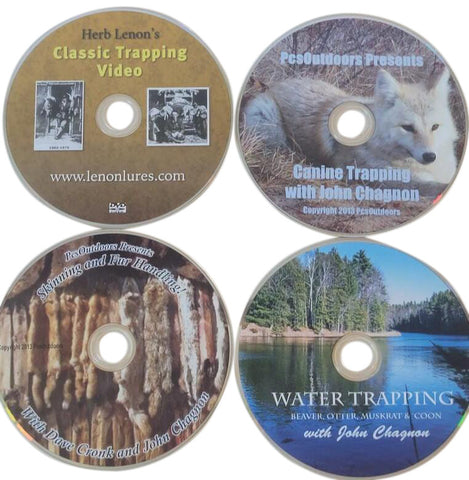Trapper's Bible of Trapline Secrets, Sets and Knowledge by Herb Lenon
"Herb Lenon wrote The Trapper's Bible nearly a century ago to help Lenon Lure customers know how to use Lenon Lures the same lures he made and used. Asa Lenon and John Chagnon have continued to make and use these extraordinary lures. The words are typed from an original copy of the The Trapper's Bible and photos added"
My reason for publishing this booklet is twofold.
I wished to do something worthwhile in appreciation of your welcome orders, and your confidence in me and my products. This is my way of saying thank you so very much. Secondly, I wished to give you instruction for using my lures properly.
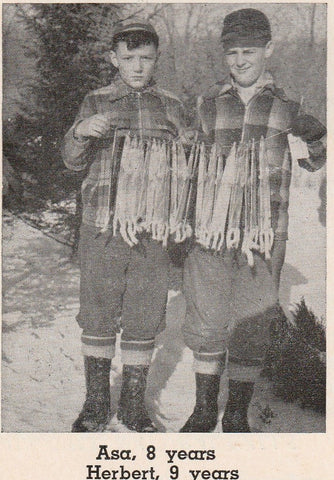
I use exactly the same lures I sell, hundreds of expert and professional trappers have used them for many years, so I know without a doubt that they are excellent lures, and that they will produce as well for any trapper if they are used as correctly.
No lure ever made will produce satisfactory if used improperly on a trapline improperly operated.
Your Trapper Friend,
HERBERT LENON
RFD No. 1
Gulliver, Michigan
Chapter 1.

Above Picture Asa Lenon & John Chagnon in the Lenon Lures Lure Building were Lenon Lures was made for nearly a century. Picture Taken Fall 2015
ANISE OIL: Oil of anise seeds, used in coyote, fox, coon, beaver, muskrat lures.
APPLE AROMATIC: Imitation apple flavor, used in muskrat lure.
AMBER OIL: Oil from subterranean resin beds; Evergreen resin odor.
ASAFETIDA OIL: Oil from a plant infused in oil; generally preferred for heavy base lures for fox, coyote, wolf, skunk.
ASAFETDA TINCT: Asafetida dissolved in alcohol for liquid lures.
AMBRETTE MUSK: An aromatic chemical, used to replace muskrat musk.
BEAVER CASTOR: Glands found just ahead of the vent. For any lure.
BEAVER OIL SACKS: Attached to castors, thick oil, for beaver lure.
BERGAMOT: Pleasant odor, from plant or its fruit, for muskrat lure.
CATNIP: Distilled from catnip plant, for muskrat and bobcat lures.
CASSIA: Oil cinnamon, for muskrat and beaver lures.
CIVET MUSK: Musk from the civet cats of Africa, for fox, coyote, wolf, bobcat lures.
CIVETTE MUSK: An imitation civet musk. Used same as civet.
CARROT OIL: Oil of carrot seeds, for muskrat lure.
CUMIN: Oil of dwarf carrot seeds, used same as carrot seed oil.
DEER MUSK TINCT: American deer musk soaked in alcohol, used in deer hunting and on jowls of dogs to prevent running deer, or on drag to train dogs to run deer.
FENNEL OIL: Fennel seeds, similar to anise, used in muskrat lure.
MINK MUSK: The anal glands of mink: Used in mink, otter lures.
MUSKRAT MUSK: Yellow glands found on belly of male rats in rutting season, used in all lures.
MUSCARO: Imitation Tonquin musk, used same as Tonquin.
PHENYLACETIC ACID: Honey odor chemical: Used in raccoon lure.
RHODIUM OIL: Synthetic rhodium oil, certain kinds used in many lures.
SWEETFLAG OIL: (Calamus) Oil of sweeflag used in muskrat lure.
SPEARMINT OIL: Oil from a mint plant used in muskrat lures.
SIBERIAN MUSK: The musk from a specie of musk deer of Asia, for wolf, coyote, lures.
SKUNK MUSK: The musk from musk glands of skunk, used in wolf, coyote, fox, bobcat and skunk lures. Also used to give long range to any lure.
TONQUIN MUSK: Musk from the musk of deer of China, India, etc., used for fox, coyote, wolf, bobcat lures.
VALERIAN OIL: Oil from roots of a plant; for coyote, skunk, fox, wolf, opossum, etc., lures.
WEASEL MUSK: Weasels anal glands, used in weasel, mink lures.
LURE: Anything that will attract an animal to a set.
SCENT: Usually a concentrated lure containing ingredients that appeal to the animal’s hunger, sex, nature or curiosity.
URINE: The secretions of animal’s kidney’s and bladder.
GLANDS: Generally the anal, leg, sex glands of animals, altho the liver, kidneys, etc., are also glands.
SET MAKERS DICTIONARY
CHAPTER II.
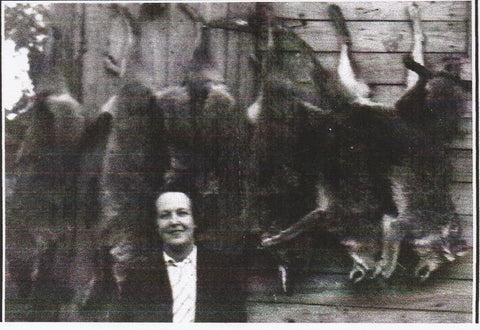
Pictured Laura Lenon - Asa Lenon Quoted one day "My mother was an excellent trapper herself," said Asa. "When Dad was working for the government, he couldn't trap for fur, so Mother, and later, us kids, ran long traplines.
HOLE SET: A set made by burying a trap level with the ground then digging a hole back of it; see chapter, “The Sets”.
OLD INDIAN SET: My way of making a hole set.
POCKET SET: Usually a hole set for mink, made at edge of water with water in front of but not in the hole.
OPEN POCKET SET: Generally a V shaped open top pocket dug at water’s edge.
SCENT POST SET: A trap set by a bunch of grass, end of log, muskrat house or any visible object or projection on which fox, coyote, wolf have been urinating.
BLIND SCENT POST: A set made by the trapper to imitate, or resembled the scent post set.
CASTORIUM POST SET: A set for beaver made by the beaver's castorium post which is usually a pile of mud or peat in which beaver deposit their excess castorium: Or a set made by the trapper to imitate such a place.
BLIND TRAIL SET: A trap well hidden in a trail used by animals.
BAIT TRAIL SET: One or more blind trail sets with a large bait placed nearby or between two such sets.
BLIND SET: Any set made so no sign of its being there can be seen.
KNOLL SET: A trap set in a prepared bed or chaff.
CHAFF SET: A trap set in a prepared bed of chaff.
CAMP FIRE SET: A trap set in a bed of ashes.
HAY STACK SET: A trap set on a pile of hay, buried in chaff.
BY PASS SET: A Blind Scent set made in a natural or made passage with trap two or three feet back from the scent.
BACK SET: A trap set two or three feet from a hole set.
REAR SET: A trap set at the rear of a hole set.
FEED BED SET: A trap set on a pile of refuse left from muskrats eating there, also called stool set.
FLOAT SET: Usually a trap set on each end of a tree foot board floating on the water, muskrat bait between the two traps.
PASSAGE SET: A trail set in a narrow passage of any kind.
TUNNEL SET: A trap set under overhanging roots, grasses which form a tunnel at waters edge, usually for mink.
CORRECT TRAPS TO USE
Chapter III.
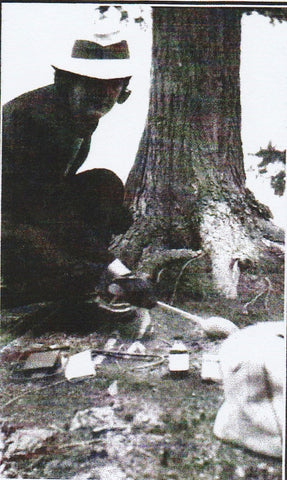
Laura Lenon, carefully constructs a coyote set, 1940.
WEASEL: Any No. 0, No. 1 or No. 1 1/2 (my favorite) No. 1 1/2 Oneida Jump, it kills weasel, therefore pelt is clean instead of bloody.
CIVET (spotted skunk): any No. 1, double jaw is best.
MUSKRAT: Any No. 1 or 1 1/2 with drowning wire, No. 1 or 1 1/2 stoploss is best. My favorite is No. 1 B & L stoploss.
MINK: Any No. 1 1/2. My favorite is No. 1 1/2 double coil spring Victor.
SKUNK: MARTEN: OPPOSUM: Any good No. 1 1/2, (my favorite) same as mink.
FOX: GREY FOX: RACCOON: FISHER: Any good No. 2 (my favorite) No. 2 c oil spring.
VICTOR: For deep snow any No. 3 (my favorite) No. 3 Victor Oneida Jump.
COYOTE: BOBCAT: Any good No. 3 (my favorite) No. 3 Victor Long Spring; for snow, No. 4 Oneida Jump (my favorite).
WOLF: Any good No. 4 or No. 14 (my favorite are) No. 4 Newhouse, No. 14 Oneida.
OTHER TRAP INFORMATION
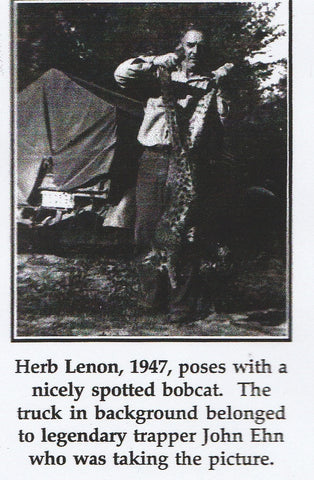
My favorite trap pads are made thus: Measure the spread of trap jaws, to this add one inch; measure width of jaws, to this add one half inch. This is the size of the pad. Tear canvass of heavy weight to above size, then one inch from one end, exactly in center, punch a small hole with a small hole with a small leather punch, this hole is for the trap dog to protrude through.
To place on trap: First place the pad under the jaws, over pan, so the dog protrudes through the little hole, then open trap jaw as over the pad, hook the trigger in the dog where it protrudes through the little hole. With such a pad even dry sand cannot get under pan. For snow, see chapter on snow trapping.
To cover trap running water pin a leaf of correct size to the trap pan using rusty paper clips.
To bed a trap in freezing weather, bed it in dry leaves or needles. Dry sand is best anti freeze in areas of little snow, dry the sand all summer in sun or in a stove oven. Cover trap with waxed paper, then cover with the dried sand, recover again same as before.
Always set the trap so the animal walks into it between, not over the jaws.
Hooking Trap Trigger: Trap triggers may be hooked into the trap dog to prevent small animals getting in large traps, to do so lay the trigger flat, holding a small file at 45 degree angle cut a sharp notch across top of trigger at its tip: then again holding the file at the same angle cut a notch in the trap dog for the hook filed in the trigger to hook into, both notches should be about one thirty second inch deep, one sixteenth inch wide. Then set trap and try its action, file off the end of the dog so pan drop of three sixteenth will release jaws. If too much weight is necessary to spring just dull the hook, if too light sharpen the hook, just as you would adjust trigger action of gun.
For Wolf 12 pounds dead weight is right, for coyote and cat eight pounds, for fox four pounds.
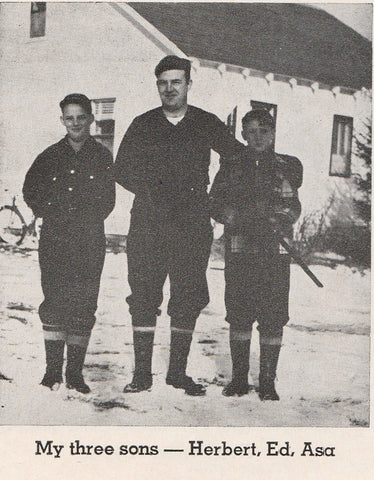
CARE OF TRAPS
CHAPTER IV.
New oily traps, very dirty or rusty traps, or traps scented by skunk, civet, porcupine, or opossum should be boiled two hours in a solution of one can lye concentrate to each 10 gallons of water, let set in the solution a day or more, boil one hour, pour off the solution, wash traps in clean water.
TANNING TRAPS
Boil traps in a solution of one pound of dyeglaze to each 35 gallons water, boil two hours, lift from boiling water, hang up to dry. I advise that branches of cedar, balsam or some aromatic local tree be used to give traps a natural odor. Place the branches under the traps. Pour dyeglaze in boiler before placing traps therein, this to prevent dye adhering to traps in clots.
Soft maple, oak, hemlock bark or walnut hulls make a good tanning solution, boil traps in it until they are dark blue.
WAXING TRAPS
The quickest, easiest way to wax traps is to melt trapglaze in the tanning solution, or in clean
water, starting with two ounces of wax per square foot of water surface, when wax is completely melted, and water is near, but not b oiling, hook three large, or six small traps on a wire, lower them under the water, leave them under water several minutes so traps are as hot as the water, then lift traps very slowly from the water, through the melted wax, hang up to cool.
If wax is too thick on traps you either lifted too slowly, or there was too much wax used.
Check traps, rewax any that have spots not covered with wax. I wax my traps thus: In a new wash boiler I melted 60 pounds of trap glaze, in the bottom of which I had placed one fair size cedar bough. To avoid danger of fire I set the boiler of trapglaze right in the big trap boiler of tanning solution, when the boiling solution brought the wax to a boil I lowered four big traps, grapples and all in the wax, left tem there 15 minutes so traps were hot, lifted them from the wax shaking off wax drops as lifted. After traps are clean be sure to hang them in a place where odors of any kind cannot contaminate them. See cleanliness in trapping.
CLEANLINESS IN TRAPPING
Chapter V.
To take the maximum possible number of animals such as fox, coyote, etc., you positively must be extremely clean in trapping.
Just remember that an animal that can follow a rabbit's track, several hours old, at a full run, can certainly smell a drop of human sweat several feet, even after a day or two, a week in dry in dry weather. Every morning don clean clothes, bathe as often as possible, wash your hands at streams when on the trapline, tie a band made of a large bandana around your head over your eye brows to prevent sweat dripping on the set, be extremely clean and careful.
I have three pairs of shoe rubbers, these are washed after one day’s setting traps, then allowed to air while a different pair are worn. I have two pair of leather gloves for hot days, two pair rubber dipped gauntlet gloves for wet or cool days.
After one day’s setting traps I wash the gloves and hang in sun until their turn comes again.
For rain or dew wet mornings, I have rubber overalls, rubber jacket and 16 inch rubber packs.
Gloves and rubbers are worn only when out of car and in vicinity of my sets, are never worn in the car or on travelled roads where leaking gas, oil, etc., from cars may contaminate them.
Traps must not be carried in a car or it’s trunk, for surely the car odors of gas, oil, cigarettes will contaminate them, this is important. I carry my traps in a clean pine box on a car top carrier, I have a short ladder to facilitate removing traps from the car top box.
When I used to make my living trapping fox, wolf, coyote, etc., in winter and deep snow I had a special pair of large leather top packs with rubber bottom, large enough to wear sheepskin packs inside, a pair of fur lined gloves, a pair of sheepskin lined mittens. They were never brought into the house, they were kept in the well house, in the morning I would put over shoes over my sheepskin packs, go to the well house and there don my packs, heavy mackinaw and Soo wool trousers which were also kept there, thus no odors of the house, etc., were ever allowed to contaminate them. The mitts and gloves were worn only when setting traps.
I bolted a pair of four foot skis on a hand sled on which I pulled heavy loads of traps, baits, etc., when trapping far from home sled and snowshoes were also kept outside.
With these precautions I would clean out every fox, coyote, for 20 miles around during January and February while other trappers could catch nothing.
One must be careful, it pays well to be so.
WIND AND VISIBILITY IN TRAPPING
Chapter VI.
Few trappers seem to recognize or understand the extreme value of wind direction and visibility in trapping. Believe me, they are two of the major so called secrets of success. For the animal to detect the odor of the lure, one must depend on the wind carrying it to them.
Here in North Michigan the wind prevails from the South and West from May to mid September, therefore traps must be set either South or West of the anticipated route of the animal. With a medium of Southwest used in placing the trap and lure. Lure SW of the trap, or trap NE of the lure, set South or West of route. In openings traps are set along the South and West side. After mid September winds are from North and West so traps are set accordingly, with a medium of NW being used.
This applies to all animals and all sets where scent, urine or baits are used.
Visibility is a factor or major importance also: there are several reasons for its importance; namely: Many nights there is no breeze, the breezes are fitful, or wind is blowing from other than the prevailing direction: Under such conditions one looses the value of the winds carrying the odor in a true course to the animal: On still nights the lure odor just spreads in all directions.
However, immediately upon smelling the lure the animal will stand on its hind feet, and look around, or it may go to a higher spot to look for the source of the odor.
If it sees a fresh hole at a hole set, or a conspicuously visible bunch of grass, tiny tree or some such object or projection, it immediately assumes the odor is coming from there. Furthermore all animals are interested in all fresh holes and it is their nature to investigate them, thus one has added the natural interest and curiosity appeal to the lure’s appeal.
With all members of the canine specie it is a natural desire to urinate on any bunch of grass, or projection that stands alone and is conspicuously visibly, therefore one has combined the urinating appeal with the lures appeal. This also applies to bobcat, and to beaver if the object imitates a castorium post. Another factor of importance is that when the animal can see the interesting hole or projection from a distance, it has time to look about for danger before approaching, when all seem safe they will approach with little caution, and with their minds on the thing of interest, not on danger.
Furthermore when they know just where they are going they will approach the trap more correctly, therefore, are much more likely to step on the desired two square inches of trap pan.
In fox, coyote, wolf trapping there must be clear visibility back of and around the set, for it is nature that just before they lower their heads to smell or eat, to take one long, cautious look about them, if set is made where a high stump, thick trees, etc., prevent their seeing about them, they will often refuse to go to the set. For this visibility and eye appeal, I use fresh bright twigs of a beaver’s favorite food or pile of peat to resemble a post, for muskrat I use a piece of red apple, yellow carrot or bright roots for eye appeal, in mink trapping I used a piece of brown fur an inch square after snow, a tiny white feather before snow, usually this was dipped in scent before placing above, or near the set.
Follow those rules whether you believe them or not. I know they are necessary, 45 years of trapping has learned me many things.
PROPER USE OF SCENTS
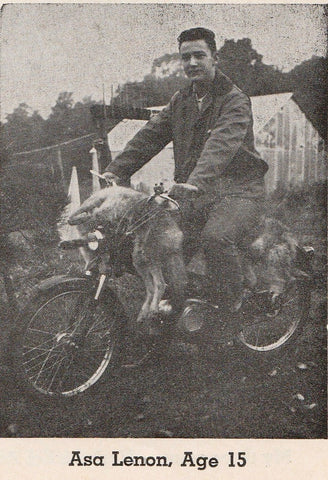
Chapter VII.
Why is it that just a few days before I started writing this booklet I received a letter from a trapper in Wisconsin saying my mink lure did not bring results, when the same week I got two letters from Wisconsin saying it was the world’s best mink lure; one trapper taking three mink with it the first night, another trapper writing he
took four mink at one set with my lure only, one of them, a big mink, he took the foot off of, then took it again at the same set, with my same lure three weeks later.
This is absolute proof that one trapper used the lure incorrectly. I strongly advise using a good quantity of scent, use at least a teaspoon of urine, 20 or 30 drops of Nature’s Call, the musk All Call, or Long Distance All Call use the quantity equal the size of a large red bean, at sets made at random, use twice as much of either type, this applies to sub zero weather also. Here in the North I pour, or place my scent in hollow knots, down home I used corn cobs or pieces of corn stalk in which I cut out a hollow in one end, this protected the lure from rain, and kept it from separating and disintegrating.
By using more it will be smelled much further by the animal, by using hollow knots, corn cobs or stalks the scent would last two to four weeks thus in the long run I used less scent than used if re-scenting with a tiny bit each trip, also one need not approach near the set every visit, thus no human odor is left near the trap until a catch necessitates resetting. One should consider also that the cost of lure is very, very small portion of a trapline’s expense, on my auto trapline, I used lures quite profusely, yet the cost of my lures figures at retail price was less than 8% of trapline expenses.
SCENTING THE HOLE TYPE SET:
In scenting hole type sets place half the scent in some hollow from protection, then place it down in the hole, place an equal amount on the outer edge of the upper lip of the hole, or on some natural object a few inches to a foot above the hole.
When small baits are used, especially in brushy areas, or where grasshoppers immediately eat the scent, place the small bait well down in the hole, sprinkle a little sand over the bait. My All Call and Long Distance lure is especially made for hole type sets.
If urine is used also, sprinkle half down in the hole, half just back of trap at the edge of the hole.
SCENTING POST TYPE SETS:
In scenting scent post, or blind sets pour the scent in the hollow protection, hide it just under the edge of the grass, or projection, on downwind side, sprinkle an equal amount over the projection, also on the down wind side. My Nature’s Call scent being a urine base with gland secretions is the proper scent for such sets, although my All Call and Long Distance scent being a heavy musk and gland lure will give excellent results at such sets.
MINK sets made in natural passage or trail are scented differently, there the scent is placed a couple feet from the trap in such a manner that he mink wishing to investigate will use the natural passage, therefore it is rather a scent trail set, scent is used at all such sets to induce any mink swimming, or up on the back to come over to the set, when it does so it will naturally use the natural passage coming, or leaving.
Weasel scent is always used with fresh bait, chicken or rabbit insides are best, scent is placed below the bait, not on it. Years of extensive testing and using has proven that with bait only, my weasel catch run only 30% large and extra large weasel, when scent was used with bait the big ones were interested and my catch run well over 50% large and extra large, this is because large and extra large weasel have no difficulty in catching more food than necessary, are never hungry, so not interested in bait, but are interested in scent.
ANOTHER VERY IMPORTANT factor in using lures for maximum results is knowing where to use each kind of lure.
All animals just like we humans have periods when we may want very much to go to a show, to a card party, etc., while at other times we would rather stay home, also we all know that a boiled egg doesn’t look so good after a big feed of steak as it does after a day without food in the woods.
I have a pet coyote, some days it wants to play and eat all the time, other days it just wants to lay down and be let alone.
A moment’s thought will tell you that a food lure or bait will produce far more satisfactory if used at sets made in areas where the animal comes in search of food when hungry, than when used in areas where the animal goes to play around after its belly is full. It will also tell you that scents will have far less interest to a very hungry animal searching diligently for food then when used where animals go to play around after they have eaten their fill. My All Call lures have a base of food odor of the animal’s favorite food to have some appeal even to the hungry animal, but they are primarily sex lures from the large quantities of musks and glands used. Nature’s Call is strictly a play area lure.
Mink and otter play for hours at spillways of old dams, beaver dams and in ripples, however they hunt food where minnows, fish, crayfish, frogs, ect., are most abundant. Coyote, fox, ect., will run and play for hours along a sandy beach, old grade, road or in areas of short grass or moss where they can do so without getting wet from dew or rain wet weeds, ect., but generally they do their hunting in areas of heavier cover where food is more abundant.
To make a long story short: Bait with All Call scents for areas where animal hunt food, Natures Call, or urine with the All Calls where they play. Used thus, scents five ten times the results as if used the opposite.
Fox feed primarily on rabbits, grouse and mice in fall and winter, young rabbits, birds’ eggs, mice and berries in summer.
Coyote feed principally on rabbits, grouse and deer in fall, winter and early spring, but on berries, cherries, eggs and rabbits in summer.
Skunk feed principally on insects, eggs and young birds and animals.
Raccoon feed principally on frogs, fish, eggs and small animals, but also on corn and fruit.
Mink feed principally on fish, frogs, crayfish, mice, clams, ect., I have actually found where mink killed rabbits many times though.
Otter feed on fish, turtles, frogs and so on, but I have found large otter hunting rabbits just like a coyote, many times. I have also found otter living on muskrats and small beaver.
USING PRESERVATIONS PROPERLY
In using preservatives in urine which is sold in 2 ounce bottles, use 1 ounce to each pint, or the full bottle to each quart.
For meat bait to be kept fresh, pour the full bottle over a quart of bait cut in the size pieces you desire, shake it well and let set where cool for a day, shake it well again, then add about the same amount of clean, fresh water as the amount of preservative used, shake it up, let it set a day, shake again and it will stay fresh indefinitely. For tainted bait let the bait pieces set in the sun or where warm until tainted, then add the preservative and later the water, just as directed for fresh bait.
Preserving fish: No odorless preservative I know of will preserve large chunks of fish, for the flesh of fish is too oily for the preservative to penetrate.
Fish should be ground with a food chopper, it may be ground fine or coarse as desired.
After the fish is ground, use preservative just as directed for meat baits.
Never fill your bait can full, for baits will swell when penetrated by preservative. Fill only about two thirds full.
Never screw to tight, but always cover with a cloth tied tightly over the top to prevent flies getting into it.
If there are tiny specks in the preservative that is OK, for it comes to me in wooden kegs and usually there are specks of sawdust or wood found in the preservative. This does no harm.
SUCESSFUL SETS
Chapter VIII.

Sheri Chagnon happy to see Asa Lenon during a visit in the spring of 2016
While the actual construction of any set is in itself important, it is not by far as important as the proper location and proper luring of the set.
By this I mean simply that the best constructed set ever made will not produce if made where animals never pass by, while a far less perfect set will produce quite well if made where many animals pass regularly.
The best scent ever made will not call animals five miles, will not overcome fear and caution to the point of making mink fight otter, fox, fight a pack of hounds to get to the set, such awful claims should be glaring sign, BEWARE.
While the expert, or professional trapper uses many, many sets, cost of printing prohibits space to describe all sets used when writing a booklet for free distribution of how to make a few sets that have proven successful to all trappers, expert or amateur.
THE HOLE TYPE SET
I recommend the hold set for all land animals, fox, grey fox, coyote, wolf, cat, fisher, coon, skunk, opossum, civet and as dry sets for otter and mink.
This past year I took 17 otter, nine mink in dry hole sets for coyote. Before making any set, read this book from the front cover.
In selecting the location for a dry land hole set always choose if possible a spot where the animals approach is over smooth, level ground where all is open about the set and where the approach is not made noisy by dry leaves or rustling grasses.
Now, let us assume you have come to the selected area where you wish to make one or several sets. Considering the prevailing wind direction, walk down wind from the set locations, then looking into the wind look the entire area over very carefully, pick out the exact spot for the set where the hole, or the scent post, will be the most visible, where the approach will be level, smooth, noiseless.
In some cases one must remove a few, or several tall ferns, weeds or a bush or two.
After selecting the location or locations, gather all tools necessary for making the set, select your trap or traps to avoid making several trips back and forth, put on your clean rubbers and gloves, proceed directly to the set location, if trapping fox, coyote or wolf, spread your kneeling pad made by sewing a rubber hospital sheet to a piece of canvass 30 by 36 inches, directly in front of where the set will be.
Lay your equipment to the right, kneel down on the pad then you are ready for the construction of the set.
MAKING THE HOLE SET
First dig or chop out a trap bed the right size to fit the trap and deep enough that when the stake is driven or the steel grapple is placed in the hold, and covered with an inch of earth the trap will set one inch below the level of the surrounding. Place the trap pad over the trap so it will not tip if the jaws or springs are first stepped on by the animal.
Selecting the most mellow earth cover the trap a half inch for small animals, three fourth inch for large animals.
Starting at the back edge of the trap bed, and off center to the left one inch or two, dig a tunnel gradually deeper until it becomes a hole the right distance back of the trap pan, hole should be somewhere around four inches in diameter, slant back into the earth at a 45 degree angle, at least six inches deep, but deep enough to furnish all earth necessary for the set.
When the trap is covered the right depth bring out more earth to build two ridges two inches high, starting at mouth of hole, and coming back one foot just clear of each jaw.
When the ridges are built, dig out enough more earth to make a little pile between the ridges and ahead of the trap just at the mouth of the hole.
Thus the trap sets between the ridges and just back of the little pile which set as guides. The trap sets centered in the lowest place between them, and somewhat to the right of center before the hole.
For Wolf and large coyote and bobcat one foot from the hole is satisfactory, for pup coyote and fox, eight inches, for skink, coon, six inches, for mink four inches.
In heavy clay areas I carry in sand to cover the trap. For freezing weather see chapter on Correct Traps To Use.
THE BLIND SCENT SET
This set is primarily for the canine specie, distance from trap to scent is same as in hole set.
Before making this set follow the preparatory instructions as given in selecting set location for hole set.
When the location is selected at a scent post, or visible projection already there, or to be placed there, approach and kneel on the kneeling pad.
First remove and lay aside the very surface covering be it sand, rotted wood, moss or leaves.
Dig the trap bed exactly same as described in the hole set, except that in this set trap should set level with or not over one fourth inch below the level.
Cover your trap with available earth and finish very carefully with the bleached surface you have laid aside, be careful, when completed all must look exactly the same as before disturbed. No ridges are used at this set, however, a few tiny twigs or pieces of bark hardpan or whatever is natural may be lain to act as guides; don’t overdo it.
Always carry all surplus earth, roots, away from the set on the kneeling pad, distribute it where it can not be seen by the animal.
Digger Fox, Coyote Set: The simplest set to take digger animals is to make the same type set, use the same the lure as being used where the animal is digging up the set. However, make this set at the edge of clear trail, than three to ten feet each way from the set make a blind trail set being careful no sign of it being visible. The digger is caught coming to, or leaving the regular set.
MUSKRAT SETS
We all know a trap set on a feed bed is one of the best, but here is another simple one.
At water’s edge dig an open pocket set dig this the shape of a letter V, ten inches long, six inches wide at mouth or water’s edge, dig deep enough so water covers trap, pull up a little earth at the bank point of the pocket, lay a few bright roots, apple or carrot on the little pile of earth for visibility place a gob of lure size of a bean in point of V using a hollow as previously explained to protect the lure from rain. My muskrat lure is a solid mass and totally waterproof.
BEAVER SETS
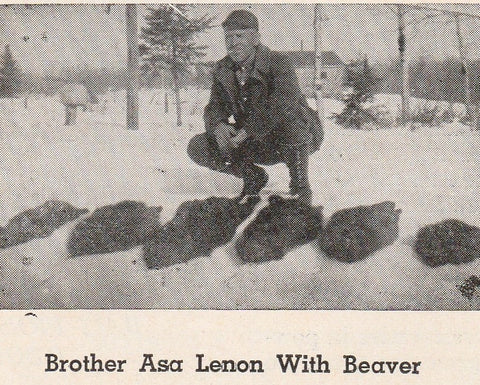
In open water make a castorium post set at the water’s edge, to make, scratch up a pile of earth or peat about eight inches long, four inches high, place a few bright twigs across this pile, place lure in a quantity the size of a large bean, protected by using a hollow as previously explained, on top the pile if earth or peat. Set trap eight inches from lure, to right or left four inches, for beavers front feet are quite wide apart, run your sliding wire or pole to water deep enough to drown the beaver.
Under ice set is made by selecting a place where there is around 18 inches of water under the ice: Cut out a piece of ice a foot wide, 2 feet long plant one bright, green bait tree about one inch in diameter at shore side, set the trap 8 inches out, 4 inches to right or left of bait tree, run drowning slide to deep water. If water is below the ice, place lure on the bait tree next to ice. Replace the ice removed, cover with snow to avoid suspicion.
WEASEL SETS

Weasel have regular travel routes which can be located by tracks after snow, however, before snow traps should be set along brushy streams or draws, rocky ledges, edge of grassy fields, etc.
Finding locations where the trap is protected from snow or sleet is the only difficulty in weasel trapping.
My favorite set is to build a box from two end pieces 6 in., square and four pieces of lumber a foot long for sides, bottom, top. Top piece is fastened with one nail in one back corner allowing it to be swung back, bait is hanged on a nail in the back end, lure is placed on the floor under the bait, trap is set and fastened with a small staple inside the box beneath a hold drilled through the front end.
These boxes are set where weasel sign is found, snow, rain, dogs, cats, etc., cannot bother set.
OTTER SET
Otter are not too intelligent; however, they have extremely sharp vision and trap must be very well covered. The difficulty in catching otter is setting the trap in such a manner that they stand on their feet when coming to it, otter slide on dry land, and swim with their front feet back.
To make a successful set find the proper location, then in the bank of stream or lake where there is a straight bank, dig a hole six inches in a diameter, a foot or more deep, straight back into the bank 18 inches above water, fresh fish bait should be rubbed on the bank around the hole, small fish, kept fresh should be placed back in the hole, otter scent should be used as described under how to scent a hole type set.
Trap is then set directly under the hole but out 8 inches from the bank and under six to ten inches of water.
As the otter attempts to investigate the hole it will place its hind feet down on the trap for solid footing.
MINK SETS
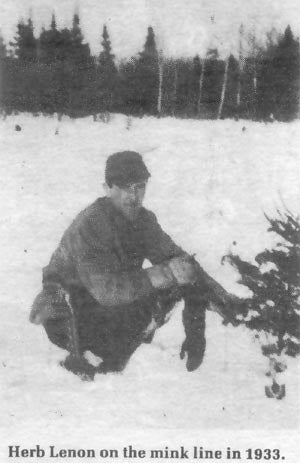
A successful mink set is made exactly as just described for otter, except the hole is about four inches in diameter, 8 inches above water and trap is set out 4 inches in 2 to 4 inches of water. Mink scent and bait is used exactly the same as used in otter set, a tiny feather or piece of fur is used just as explained in Proper Use of Lure chapter.
The mink pocket set is a set made where the pocket or hole is dug so there is 2 inches of water in mouth of hole, but hole itself is above water, bait and lure is used the same way as in the feather or fur; trap is set under water at the pocket’s mouth.
A much used, successful blind mink set is made thus: After finding where mink are running the water’s edge on a low bank, follow the tracks to where something, possible a steep bank, stone, stump, etc., forces the mink to take to water, or up the bank, set a trap right where the first hop of the mink will be as it takes water, plant a small twig at traps jaw out in stream to guide the minks hop, further up stream about two feet place a goodly quantity of lure. This lure is to cause the mink to take water rather than climb up the bank; to call mink swimming, or already up or the bank to come down and use the natural blind set coming to, or leaving the scent.
WINTER AND SNOW TRAPPING
Chapter IX.
Mink sets in winter can be made in warm springs or streams that do not freeze, they can be made under shelf ice same as before ice, or made in hollow logs, under over hanging roots or grasses where snow or sleet will not bother.
Winter muskrat sets are often made at air holes under the snow where rats have made the hole, then kept it plugged with moss and mud to prevent freezing.
Trapping fox, coyote, etc., where snowfall is light, one may dig the trap beds and dirt holes before freezing weather, traps are then set and covered with dried sand as preciously instructed.
Fisher and bobcat are often trapped in large natural, or made cubbies, Marten are usually trapped by setting the trap on a limb, or lean pole above snow levels, with roof made over the trap to protect it from snow.
Deep Snow trapping is very difficult, although I have caught hundreds of fox, coyote, cat, etc., in deep snow, it was very difficult.
Here is one of my favorite sets:
Upon finding a scent post being used by the animal, or upon finding a suitable place where they travel to establish a scent post set, I proceed as follows:
I approach as near as possible to the set location behind a tree, stump or whatever hides my tracks whenever possible, I than walk directly to the set spot: out from the scent exactly the same as described in dry Blind Scent set, I pick the exact spot for my trap. I then pack the snow where the trap is to be set to give trap a solid foundation, if in evergreen tree area, I then lay evergreen leaves on this packed snow and set trap on them, then cover with wax paper that has been crushed to remove its noisiness, if not in evergreen area I wrap the entire trap loosely in crushed wax paper. When trap is properly placed the right distance from the scent, and two inches lower than the surrounding snow, I reach back of me with the snow spoon I will describe and holding the snow three feet above the trap, I carefully sift snow over the trap until all is level and natural.
Snow must be sifted over the trap from two or three feet, allowing it to gather air as it falls, or it will freeze hard over the trap. I then back away smoothing out all my tracks with the snow spoon, every few feet away stopping to throw snow up and over all signs. Tracks are thus blotted out for 50 feet, or until hidden by some object such as a tree, stump, large log, etc.
MAKING A SNOW SPOON
This is handiest, and only really successful snow tool I ever used, however, without it one can brush out sign quite well with a tree limb, 4 ft. long, curved on the end like a hockey stick. A snow spoon works so good it is worthwhile making it you intend trapping in deep snow.
To make, choose a piece of soft wood, cedar or cottonwood is very soft, first cut a good spoon handle on the block of wood 6 inches long, checker it so it will not be slippery, then cut out the balance exactly the shape of a spoon, round and smooth on the bottom, hollowed out some like a spoon on top.
Have the bottom very smooth and nicely rounded, it should be one foot or more in length, eight to ten inches in width, handle six inches. When completely made and smoothed, heat the spoon in the stove even, and paint with smoking hot wax until well coated with wax. Waxing is necessary to avoid its getting wet, and prevent snow sticking to it.
Believe me, when you smooth out your tracks, then throw snow up and over the smoothed areas, no one can see a sign of your being there.
WHERE TO TRAP IN WINTER
Chapter X.
I believe the question most often asked me by trappers is “Where do animals go in winter”. And they especially ask where mink go, saying that although mink signs were plentiful in November, none are found in January.
Not knowing the particular type area, cover, stream conditions and topography in their area, one must answer in generalities.
The major factor is probably food abundance and availability; with protection from the elements secondary.
Fox, coyote, wolf and cat are generally found in heavy cover during winter, for here they have both cover for protection, and usually the most abundant supply of rabbits, grouse, deer, both dead or alive, while even the abundant mice may be found in grassy areas they are protected by deep snow in the north, frozen ground in the winter.
Skunks, raccoon, etc., of course, hibernate in the cold North.
Where do mink go? Well, that depends on several conditions, in one place where I trapped there were many warm open spring creeks, while the larger streams seldom had air space beneath the ice, this due to water flooding over the ice with every thaw on very severe freeze.
In that area mink went to the small open spring brooks.
In another area I trapped conditions were opposite. There were no small, warm, open streams, the topography being opposite also, mink went to the larger streams, and lived under the ice, for the streams most always had from a few inches to several feet of air space beneath the ice.
The ice gave protection from severe cold and deep snow, the mink fed and traveled beneath the ice just as they did when the stream was open.
In yet another area I trapped mink fed on the small streams of the areas in fall, but when severe cold came all streams froze solid as they were primarily rain water streams, not spring fed. Here the mink usually went to dense swampy areas feeding on muskrat, rabbits, mice, often taking excursions to grassy areas and cornfields for mice.
NOTE: This booklet is published for you with the best wishes and many thanks of Herbert Lenon, Gulliver, Mich., and Mr. P.L. Stamp, Stronghurst, Illinois.
Thank you very much for your past orders, we hope to be able to give you satisfactory products for many, many years to come.
ATTENTION!
Only one copy of this book will be given to each customer, not one with each order unless requested.
Should you desire more than one copy for a friend or yourself please send $0.25 for each additional copy.
This booklet is for Lenon and Stamp customers only, it is not for sale to others.
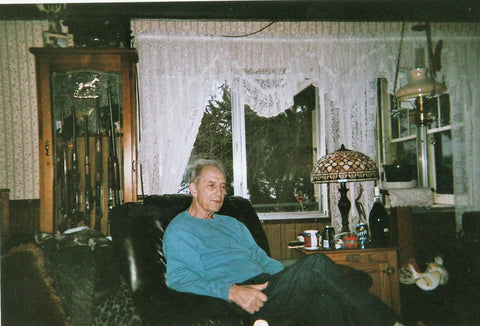
Asa Lenon, Gulliver Michigan 2015 My fondest memories were when I sat across from Mr. Lenon during our many conversations over the years, John Chagnon
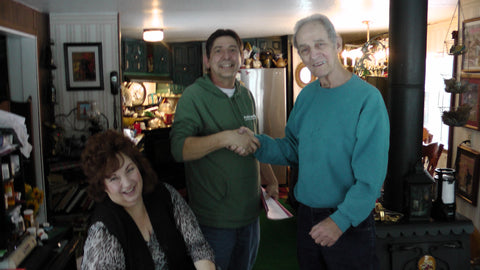
Maria & Asa Lenon and John chagnon 2015 Maria Lenon passed in 2016 but will always be remembered for her smile and kind heart.
Trappers check out our Dvd's Video on Trapping Furbearing Animals Herbert Lenon's Trapping video
Herbert Lenon and John Chagnon Trapping and Fur Handling Videos Dvd's
Herbert Lenon and John Chagnon Trapping and Fur Handling Videos Dvd's
Ebay carries all of Lenon Lures® products and is a great place to find deals on all kinds of used and new traps & equipment for coyote, fox, bobcat and wolf trapping at great prices.
Follow the links below to some more great trapping information on Lenon Lures website ...
